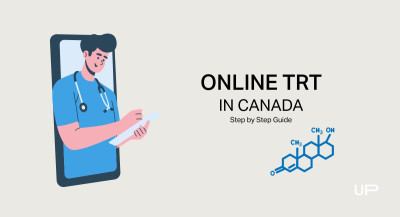TRT Vs Peptide Therapy: What Actually Works For Low Testosterone?


In recent years, more men in Canada have started looking for ways to boost testosterone, driven by concerns like fatigue, low energy, reduced libido, and difficulty building muscle.

While social media and wellness trends often promote supplements, injections, and so-called “biohacks,” not all of these options are medically approved or safe. In fact, some treatments circulating online, such as peptide therapies, are not authorized by Health Canada for testosterone use.
By contrast, testosterone replacement therapy (TRT) in Canada remains a regulated, evidence-based medical treatment prescribed by licensed practitioners.
Understanding how TRT differs from unapproved alternatives like peptides, in both science and safety, is the first step toward making an informed, health-conscious choice.
Topics covered in this article:
- Key Takeaways (1-Minute Summary)
- What Is Testosterone Replacement Therapy (TRT)
- What Are Peptide Therapies
- TRT vs Peptides: Mechanism, Regulation, Evidence
- Safety, Side Effects, and Monitoring
- When TRT Is Indicated vs When Peptides Are Considered
- Lifestyle and Adjunctive Supports
- Conclusion: Making an Informed Choice in Canada
- Frequently Asked Questions
- References
Key Takeaways (1-Minute Summary)
- TRT (Testosterone Replacement Therapy) is the only Health Canada–approved medical treatment for men with confirmed low testosterone.
- Peptide therapies promoted for testosterone or “performance” enhancement (like CJC-1295, Ipamorelin, or BPC-157) are not authorized in Canada and lack solid human research.
- TRT replaces testosterone directly and is prescribed under medical supervision with lab testing to ensure safety and effectiveness.
- Peptides claim to stimulate the body’s own hormone production, but their effects are unproven, unregulated, and potentially risky.
- Men in Canada seeking to address fatigue, low libido, or muscle loss should start with proper testing and licensed medical care, not unverified online products.

What Is Testosterone Replacement Therapy (TRT)
For men diagnosed with clinically low testosterone, testosterone replacement therapy (TRT) offers a proven, medically supervised way to restore hormone balance. Before comparing TRT to peptides, it’s important to understand what this treatment is, how it works, and why it’s often considered the gold standard in testosterone care.
TRT Overview
TRT involves supplementing the body with bioidentical testosterone to bring hormone levels back into a healthy range. It addresses symptoms caused by low testosterone, such as:
- Persistent fatigue and lack of motivation
- Decreased libido and sexual performance
- Reduced muscle mass and strength
- Mood changes, irritability, or depression
- Increased body fat and slower metabolism
Forms of TRT in Canada
In Canada, licensed healthcare providers prescribe TRT mainly in these medically approved forms:
- Injections: The most common and cost-effective option, usually given every 1–2 weeks.
- Transdermal gels or creams: Applied daily to the skin for steady absorption.
Common options include injections and daily gels. Patch products are not currently marketed in Canada, and pellet implants are not approved here.
Medical Supervision & Monitoring
TRT should always be prescribed and monitored by a licensed healthcare provider. In Canada, this includes initial lab testing, ongoing follow-ups, and dose adjustments to ensure safety and effectiveness. Blood tests help monitor testosterone levels, blood count, and other key health markers over time.
TRT is not about “boosting” hormones beyond normal—it’s about restoring balance under proper medical guidance. This approach makes it one of the most effective and well-regulated solutions for men with confirmed low testosterone.
What Are Peptide Therapies
Alongside medically approved treatments like TRT, peptide therapy has become a trending topic among men looking to improve hormone health and overall vitality. Peptides are short chains of amino acids that act as signalling molecules, helping the body trigger certain biological functions.
When we refer to “peptide therapy” in this article, we mean unapproved peptides marketed for testosterone or performance purposes (such as CJC-1295, Ipamorelin, or BPC-157), not prescription peptide drugs that are approved in Canada for other medical conditions.
When it comes to testosterone, some peptides are believed to stimulate the body’s natural hormone production rather than replacing testosterone directly.

Common Peptides Linked to Testosterone Support
While research is still developing, a few peptide compounds are often mentioned in discussions about hormone balance and wellness:
- Ipamorelin: Thought to increase growth hormone release, which may indirectly influence energy and muscle tone.
- CJC-1295: Often paired with Ipamorelin, this peptide may help improve sleep and recovery, potentially supporting testosterone-related pathways.
- BPC-157: Known more for tissue repair than testosterone production, yet frequently marketed for “performance” benefits.
How Peptides Differ from TRT
Unlike testosterone replacement therapy (TRT), peptides do not supply testosterone to the body. Instead, they signal the pituitary gland or other tissues to produce more hormones naturally. This makes their effects less predictable and highly dependent on individual health factors. In Canada, peptides are not approved by Health Canada for testosterone therapy, and most are sold as research compounds rather than prescription medications.
Peptide therapy may hold promise in certain areas of regenerative medicine, but its role in managing low testosterone is not yet supported by large-scale clinical trials. For men seeking reliable improvement in confirmed low-T, regulated TRT in Canada remains the safer and more evidence-based choice.
TRT vs Peptides: Mechanism, Regulation, Evidence
When comparing testosterone replacement therapy (TRT) to peptide therapy, the key differences lie in how they work, how they’re regulated, and the level of clinical evidence supporting each. This section helps clarify these distinctions so readers understand why one is considered a legitimate medical treatment and the other remains experimental in Canada.
Mechanism of Action
TRT delivers bioidentical testosterone to the body, directly restoring hormone levels that have fallen below the normal range. It targets the cause of symptoms linked to clinically low testosterone, helping improve energy, mood, libido, and muscle mass.
Peptides, by contrast, are short amino acid chains that aim to stimulate the body’s own hormone production. Instead of replacing testosterone, they send signals to glands like the pituitary to encourage natural secretion. However, their effects on testosterone levels are indirect and not consistently proven in scientific studies.
Regulation and Safety
In Canada, TRT is a Health Canada–approved medical therapy prescribed by licensed healthcare professionals. It requires a confirmed diagnosis of low testosterone through blood testing, and treatment is monitored with ongoing lab reviews to ensure safety and optimal results.
Peptide therapies, however, are not authorized by Health Canada for testosterone use. Many peptides circulating online are sold as “research compounds,” meaning they have not been evaluated for safety, quality, or effectiveness. Some even carry contamination or dosing risks when purchased from unregulated sources.

Scientific Evidence
TRT’s effectiveness is supported by decades of research and clinical guidelines from reputable medical organizations worldwide. Numerous studies have confirmed its benefits for men with hypogonadism when used under medical supervision.
Peptide therapy, on the other hand, lacks large-scale, peer-reviewed evidence demonstrating sustained testosterone increases or long-term safety in humans. Much of the available information comes from preliminary animal studies or anecdotal reports rather than regulated clinical trials.
In summary, TRT is a regulated, evidence-based medical treatment, while peptide therapy remains an unapproved and experimental approach. Understanding these differences helps men in Canada make decisions grounded in science, safety, and trusted medical care.
Safety, Side Effects, and Monitoring
Before beginning any hormone-related treatment, safety should always come first. Understanding what to expect and how each approach is monitored helps men make informed, responsible choices. While both testosterone replacement therapy (TRT) and peptides are often discussed in the same online spaces, their safety profiles and medical oversight are very different.
Safety and Supervision with TRT
When prescribed by a licensed healthcare provider, TRT in Canada follows clear clinical guidelines. Before treatment, men undergo blood tests to confirm low testosterone and rule out other causes of symptoms. Once therapy begins, patients are regularly monitored for hormone balance and overall health.
Common aspects of responsible TRT care include:
- Baseline testing for testosterone levels, blood count, and prostate-specific antigen (PSA)
- Ongoing lab follow-ups every few months to track results and adjust dosage
- Doctor oversight to ensure no adverse effects on heart health or red blood cell count
- Open communication about any mood or physical changes
Side Effects of TRT
Like any medical therapy, TRT may have manageable side effects, especially if dosages are not personalized or monitored. These can include:
- Mild acne or oily skin
- Temporary increase in red blood cell count
- Breast tenderness or swelling
- Mood changes if levels fluctuate
- When supervised properly, these effects are typically mild and reversible.
Safety Concerns with Peptides
Peptide products marketed for testosterone boosting are not approved by Health Canada, which means they are not subject to the same safety or quality testing as prescription medications. Potential concerns include:
- Unknown or inconsistent dosing
- Contamination or impurities in unregulated products
- Unpredictable interactions with other hormones
- Lack of medical monitoring or long-term data
Because these products are often sold online or through non-medical channels, users may not receive any professional guidance, making adverse reactions more likely and harder to detect.
The Value of Medical Oversight
Regular medical supervision is what makes TRT both effective and safe. Healthcare providers track progress, fine-tune treatment, and ensure all lab markers remain within healthy ranges. Peptide therapies, by contrast, operate without such structured follow-up or regulatory protection.
In short, while TRT is carefully monitored and supported by evidence, peptide therapies carry unknown risks due to limited oversight and lack of approval in Canada.
When TRT Is Indicated vs When Peptides Are Considered
Many men experience symptoms that feel like low testosterone — fatigue, mood swings, low libido, or slower muscle recovery. But the right treatment depends on what’s actually happening inside the body. Understanding when testosterone replacement therapy (TRT) is appropriate, and when peptide-based approaches are sometimes discussed, helps clarify who truly benefits from each.

When TRT Is Recommended
TRT is prescribed only after medical testing confirms clinically low testosterone levels. A healthcare provider evaluates symptoms, reviews lab results, and rules out other causes such as stress, thyroid dysfunction, or poor sleep.
TRT may be indicated when:
- Blood tests consistently show low total or free testosterone levels
- Symptoms such as fatigue, decreased libido, or loss of muscle mass are present
- Other underlying conditions have been ruled out
- The patient is under ongoing medical supervision to monitor hormone levels and overall health
In these cases, TRT replaces the testosterone the body can no longer produce sufficiently, restoring normal levels and improving quality of life.
When Peptides Are Discussed
Peptides are sometimes mentioned online or in certain wellness settings as a “natural alternative” for hormone support. They are theorized to stimulate the body’s own hormone production, rather than replace it. However, these claims are not backed by strong human research, and the products themselves are not authorized by Health Canada.
Peptides might be discussed:
- As part of unregulated “biohacking” or anti-aging programs
- In gyms or wellness clinics without medical oversight
- For experimental purposes, often without published clinical data
In such situations, the risks outweigh the potential benefits — especially since product purity and dosing cannot be guaranteed.
Why Regulation Matters
The difference isn’t just about how TRT and peptides work; it’s about the framework that protects patients. TRT is a regulated medical therapy, prescribed based on lab results and tailored to the individual. Peptides, on the other hand, lack that safety net.
Ultimately, TRT is indicated for men with confirmed low testosterone under physician care, while peptides remain unapproved and experimental in Canada. Anyone exploring hormone-related therapies should begin with proper testing and medical advice before making decisions based on online trends.
Lifestyle and Adjunctive Supports
Even though testosterone replacement therapy (TRT) is the most effective treatment for men diagnosed with low testosterone, lifestyle choices play a powerful supporting role in maintaining hormonal balance and maximizing the benefits of therapy. For men who do not meet the clinical criteria for TRT, these same steps can also help naturally support healthy testosterone levels and overall well-being.
Healthy Lifestyle Foundations
Several key lifestyle factors have been shown to influence hormone production and response:
- Regular exercise: Strength training and moderate-intensity cardio both promote testosterone balance and improve energy levels.
- Nutritious diet: Adequate protein, healthy fats, and micronutrients such as zinc, vitamin D, and magnesium contribute to hormone synthesis.
- Consistent sleep: Restorative sleep supports testosterone release, muscle recovery, and mood stability.
- Stress management: Chronic stress raises cortisol, a hormone that can suppress testosterone. Practices like mindfulness, deep breathing, or yoga can help.
- Moderation in alcohol and weight control: Excess body fat, particularly around the abdomen, can negatively affect testosterone metabolism.
Supporting TRT Outcomes
For men receiving TRT, these lifestyle habits enhance treatment results. Proper nutrition and physical activity improve how the body utilizes testosterone, while good sleep and stress management support steady hormone levels. Physicians often encourage patients on TRT to maintain these habits to achieve more sustainable results.
Caution with Unregulated Enhancers
Online discussions often promote supplements or peptides as quick fixes for hormone issues. However, most of these products lack regulatory approval or scientific evidence. Relying on lifestyle improvement and medically guided therapy remains the safest and most effective combination for long-term hormone health in Canada.
A healthy lifestyle doesn’t replace medical care when testosterone is clinically low, but it complements therapy and helps maintain stability once levels are restored. Building these foundations benefits every man, with or without TRT.

Conclusion: Making an Informed Choice in Canada
When it comes to restoring healthy testosterone levels, it’s easy to get lost in a sea of online advice, “biohacks,” and quick promises. But the truth is clear: only testosterone replacement therapy (TRT) is a medically approved, evidence-based treatment for men with confirmed low testosterone in Canada. It’s regulated, physician-supervised, and supported by years of clinical data demonstrating safety and effectiveness.
Peptide therapies, despite their growing popularity in certain online spaces, remain unapproved and unregulated for testosterone use in Canada. Their long-term safety, dosing standards, and outcomes have not been validated through human clinical trials. For most men, using these products outside medical supervision can pose unnecessary health risks with uncertain results.
For anyone experiencing symptoms like fatigue, reduced libido, or low energy, the first and most responsible step is proper testing and medical evaluation. Licensed practitioners can assess hormone levels, rule out other causes, and guide patients toward safe, evidence-based care.
By combining responsible medical guidance with healthy lifestyle habits, men can make confident decisions that protect their long-term well-being. And when clinically indicated, TRT in Canada remains the trusted, regulated, and effective choice for restoring hormonal balance.
Frequently Asked Questions
To help clarify the most common concerns around testosterone therapy and peptide use in Canada, here are answers to a few key questions readers often ask.
Yes. TRT is a Health Canada–approved medical treatment prescribed to men with diagnosed low testosterone, also known as hypogonadism. It can only be obtained through a prescription and is supervised by a licensed healthcare professional.
No. As of now, peptide therapies are not approved by Health Canada for testosterone or hormone-related treatment. Many peptide products found online are considered “research compounds” and have not been reviewed for safety, quality, or effectiveness.
There is no reliable clinical evidence that peptide therapy can raise testosterone levels in men with confirmed low-T. Some peptides may influence hormone signalling indirectly, but their effects are inconsistent, short-lived, and unproven in large human studies.
Many men start noticing improvements in energy, mood, and libido within a few weeks, though physical changes like muscle gain and fat loss can take several months. Results vary based on dosage, baseline hormone levels, and lifestyle habits such as sleep, exercise, and diet.
If you’ve used peptides purchased online or abroad, it’s important to stop self-administration and consult a licensed provider before starting TRT. Your doctor will order lab tests to assess hormone levels and design a safe, individualized treatment plan that meets Canadian medical standards.
When managed responsibly under medical supervision, TRT is considered safe and effective for men with confirmed low testosterone. Regular follow-ups, lab testing, and lifestyle balance ensure that benefits outweigh potential side effects.
The best first step is to book a blood test and medical consultation with a licensed practitioner in Canada. A professional evaluation ensures the right diagnosis and treatment approach—rather than relying on unverified online solutions or unapproved substances.
References
UPGUYS has strict sourcing guidelines to ensure our content is accurate and current. We rely on peer-reviewed studies, academic research institutions, and medical associations. We strive to use primary sources and refrain from using tertiary references.- Unauthorized injectable peptide drugs seized and sold by Canada Peptide may pose serious health risks, Canada,
https://recalls-rappels.canada.ca/en/alert-recall/unauthorized-injectable-peptide-drugs-seized-and-sold-canada-peptide-may-pose-serious - Discontinuation report ANDRODERM, Drug Shortages Canada,
https://www.drugshortagescanada.ca/discontinuance/150081 - Unauthorized injectable peptide drugs seized from Optimum Wellness Centre in Calgary, Alberta may pose serious health risks, Canada,
https://recalls-rappels.canada.ca/en/alert-recall/unauthorized-injectable-peptide-drugs-seized-optimum-wellness-centre-calgary-alberta
This article is written for informational purposes only and does not constitute medical advice. The information provided in the articles cannot and should not replace advice from a healthcare professional. Talk to your healthcare provider about any physical or mental health concerns or the risks and benefits of any treatment or medication.





